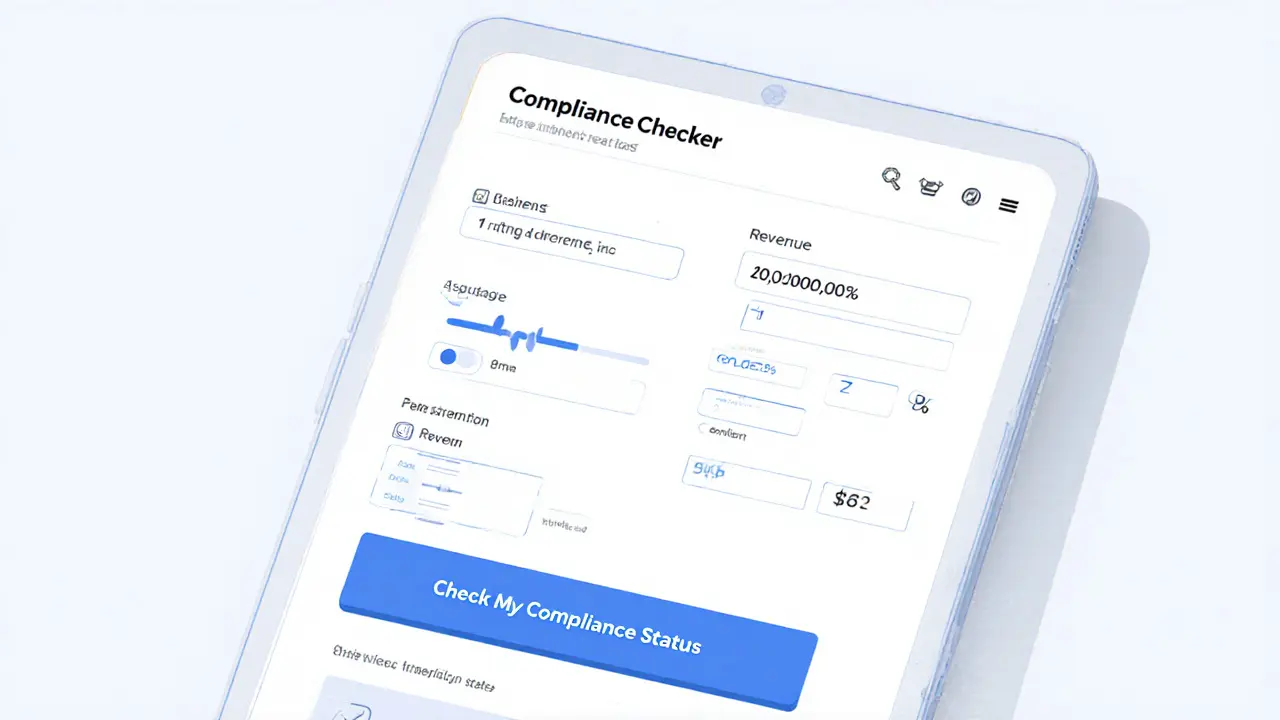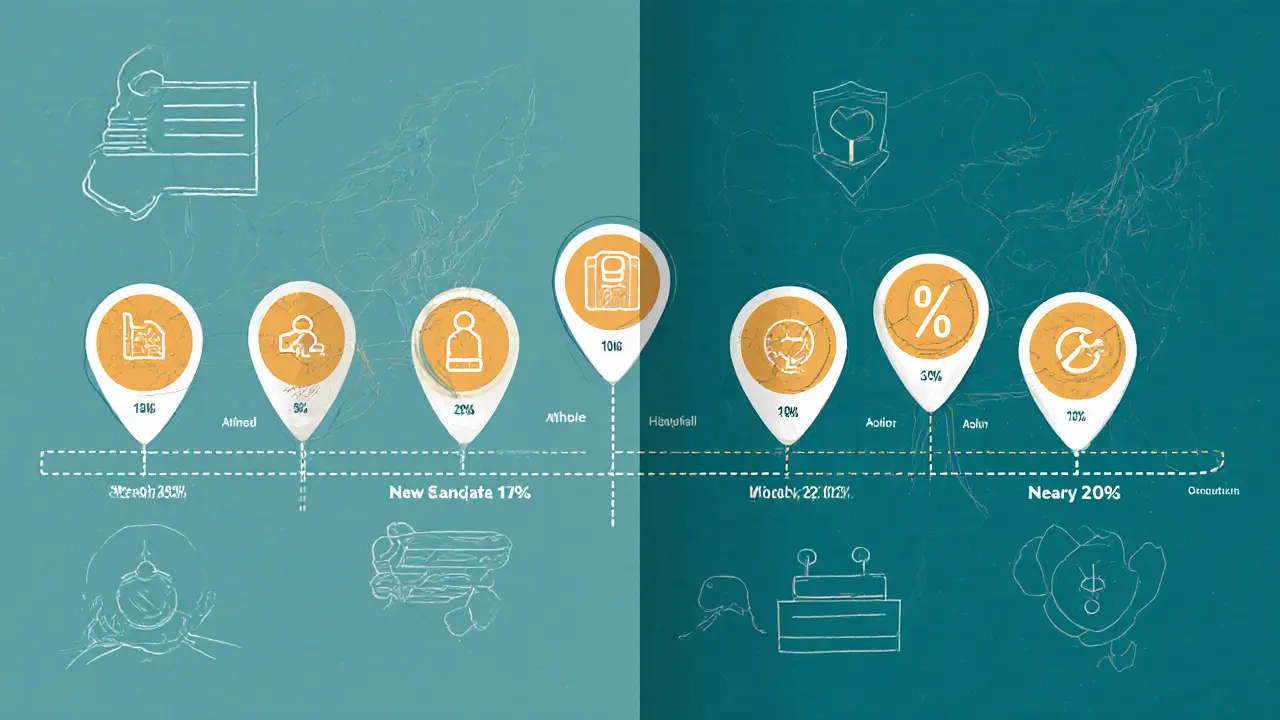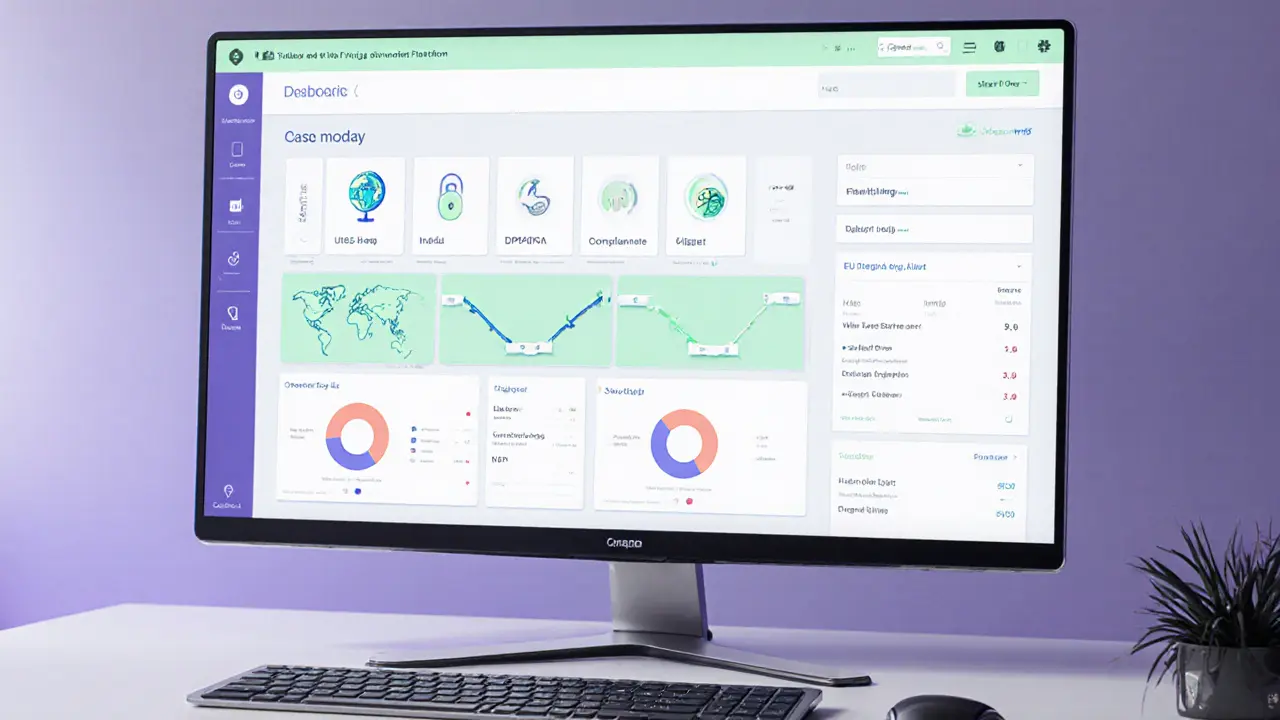2025 Privacy Protocol Regulations: U.S. State Laws & Global Framework

2025 U.S. State Privacy Law Compliance Checker
2025 is the year privacy professionals have been waiting for - a cascade of new state statutes plus fresh global mandates are reshaping how companies treat personal data. privacy regulations 2025 bring eight fresh U.S. state laws, tighten consent rules under the FCC, and add a heavyweight Indian act that will affect any organization handling Indian residents’ data. If you’re juggling customers in multiple states or selling abroad, you need to know which rules bite, when they start, and what they demand.
What the New U.S. State Landscape Looks Like
All eight statutes share a common goal - give consumers more control - but they differ on thresholds, timelines, and penalties. Below is a quick rundown of each law’s headline features.
- Iowa Consumer Privacy Act (ICPA) - effective Jan12025; applies to any business that processes data of 100,000+ Iowans or derives >25% of revenue from data sales.
- Delaware Personal Data Privacy Act (DPDPA) - effective Jan12025; low threshold of 35,000 consumers (or 10,000 if >20% of revenue comes from data sales).
- New Hampshire Consumer Expectation of Privacy (NHCEP) - effective Jan12025; applies when personal data of 25,000 residents is processed annually.
- New Jersey Consumer Privacy Act (NJCPA) - effective Jan152025; threshold 100,000 residents or 25% of revenue from data sales.
- Nebraska Data Privacy Act (NDPA) - effective Jan12025; applies to entities handling data of 75,000 Nebraskans.
- Tennessee Information Protection Act (TIPA) - effective July12025; threshold 100,000 Tennesseans.
- Minnesota Consumer Data Privacy Act (CDPA) - effective July152025; threshold 100,000 Minnesotans.
- Maryland Online Data Privacy Act (MODPA) - effective Oct12025; applies to businesses processing data of 100,000 Maryland residents.
Key Compliance Elements That Appear Across the Board
Even with the variety, most statutes converge on a handful of core duties.
- Consumer Rights - access, delete, and often opt‑out of data sales. Some states (Iowa) limit opt‑out to sales only, while Delaware and New Jersey also cover profiling and targeted ads.
- Request Timelines - most require a response within 30‑45days. Iowa is the slowest at 90days; Delaware pushes for 45days.
- Cure Periods - the window to fix a violation before penalties apply. Delaware starts at 60days (shrinking after Jan12026); Maryland offers the longest at 60days lasting until April12027.
- Fines - range from $7,500 per breach (Iowa) to $10,000 (Delaware), with higher amounts possible for repeated violations.
- Third‑Party Disclosure - Delaware mandates a public list of every third party receiving personal data, a requirement not echoed elsewhere.
Side‑by‑Side Comparison of Core Attributes
| Law | Effective Date | Applicability Threshold | Consumer Request Response | Cure Period | Max Fine per Violation |
|---|---|---|---|---|---|
| Iowa Consumer Privacy Act (ICPA) | Jan12025 | 100,000 residents or 25% revenue from data sales | 90days | 90days (permanent) | $7,500 |
| Delaware Personal Data Privacy Act (DPDPA) | Jan12025 | 35,000 consumers (10,000 if >20% revenue from data sales) | 45days | 60days (ends Jan12026) | $10,000 |
| New Hampshire Consumer Expectation of Privacy (NHCEP) | Jan12025 | 25,000 residents | 45days | 60days | $10,000 |
| New Jersey Consumer Privacy Act (NJCPA) | Jan152025 | 100,000 residents or 25% revenue from data sales | 30days | 30days (until July152026) | $10,000 |
| Nebraska Data Privacy Act (NDPA) | Jan12025 | 75,000 residents | 30days | 30days | $10,000 |
| Tennessee Information Protection Act (TIPA) | Jul12025 | 100,000 residents | 30days | 30days | $10,000 |
| Minnesota Consumer Data Privacy Act (CDPA) | Jul152025 | 100,000 residents | 30days | 30days (until Jan312026) | $10,000 |
| Maryland Online Data Privacy Act (MODPA) | Oct12025 | 100,000 residents | 30days | 60days (until Apr12027) | $10,000 |

Global Privacy Frameworks Adding to the Mix
While the U.S. is fragmenting, other jurisdictions are consolidating their rules.
- India Digital Personal Data Protection Act (DPDPA) - slated for July2025. It imposes notice‑and‑consent requirements, limited data retention, and stiff penalties (up to 4% of global turnover). Any firm processing Indian residents’ data, even from abroad, must appoint a data fiduciary and report breaches within 72hours.
- European Union - the Digital Operational Resilience Act (DORA), EU AI Act, and NIS2 Directive continue to tighten cybersecurity, AI‑risk, and network‑security obligations for any business serving EU citizens.
In practice, a multinational that sells to U.S. consumers, streams content to EU users, and offers an app in India will need a unified privacy governance platform that can toggle thresholds, consent flows, and breach‑reporting timelines on the fly.
Practical Steps to Get Ahead of 2025 Obligations
- Map Your Data Landscape - inventory every personal data set, note which state(s) the data belongs to, and tag it with the applicable law’s threshold.
- Build a Centralized DSAR Engine - automate request intake, verification, and fulfillment. Most states require a 30‑day window; design for the longest (90days for Iowa).
- Publish Third‑Party Disclosures - if you do business in Delaware, create a publicly accessible list of every vendor, processor, or partner that receives personal data.
- Layer Consent Mechanics - implement granular consent checkboxes for data sales, profiling, and targeted ads. Separate consent for each purpose to satisfy NJ, DE, and Indian rules.
- Test Your Breach Response - run tabletop drills that simulate a breach affecting Indian residents (72‑hour report) and a U.S. resident (state‑specific notification windows).
- Monitor Legislative Updates - many states have sunset clauses that will lower thresholds or extend cure periods after 2026. Subscribe to a privacy‑law tracker or use a regulatory‑intelligence service.
Common Pitfalls and How to Avoid Them
Even seasoned privacy teams slip up when juggling eight state statutes plus global rules.
- Assuming One Size Fits All - applying a single DSAR workflow ignores Iowa’s 90‑day window and Delaware’s strict third‑party list requirement.
- Missing Small‑Business Exemptions - some laws carve out entities with under $25million annual revenue; verify thresholds before over‑engineering compliance.
- Overlooking Non‑Consumer Data - HIPAA‑covered health information is exempt in Delaware, but patient contact details used for appointment reminders still fall under DPDPA.
- Neglecting FCC TCPA Changes - new 2025 texting consent rules require written opt‑in for marketing messages; treat this as a separate consent layer from privacy‑law opt‑outs.
- Failing to Document Good Faith - if a regulator cites you, a well‑kept audit trail of policy updates, training, and breach drills can halve potential fines.
What Comes Next? Preparing for 2026 and Beyond
Most state laws have built‑in “cure periods” that end in 2026 or 2027, after which penalties become steeper. Planning now means you won’t need a massive overhaul next year. Consider these forward‑looking actions:
- Adopt a policy‑as‑code framework so that rule changes automatically flow into automated compliance checks.
- Invest in a data‑mapping tool that supports “what‑if” scenarios - e.g., what happens if Delaware tightens its definition of sensitive data?
- Engage a cross‑functional privacy steering committee (legal, engineering, marketing) to review any new state bill before it becomes law.

Frequently Asked Questions
Do I need to comply with every state law if I only have a few customers in each state?
Yes. Most statutes trigger obligations once you process personal data of the specified number of residents, even if it’s just a handful of customers. For example, Delaware’s threshold is 35,000, but if you cross that number you must comply across the board.
How does the Indian DPDPA interact with the U.S. state laws?
They operate independently. If you collect data from Indian residents, you must meet Indian consent, breach‑reporting, and fiduciary duties regardless of any U.S. obligations. Overlap occurs mainly in record‑keeping - a single data inventory can satisfy both regimes.
What’s the biggest difference between Iowa’s and Delaware’s opt‑out rights?
Iowa limits opt‑out strictly to the sale of data. Delaware expands it to profiling, targeted advertising, and even certain automated decision‑making processes, giving consumers broader control.
Do the new FCC TCPA texting rules count as a privacy law?
They’re a communications regulation focused on consent for telemarketing calls and texts. They sit alongside privacy statutes, so you’ll need separate consent capture for marketing messages, but they don’t replace the data‑access rights in state privacy acts.
How can I prove I’ve complied if a regulator audits me?
Maintain an audit log of every request, the date it was received, the actions taken, and the final outcome. Keep policy versions, training records, and third‑party disclosure lists up‑to‑date. A well‑documented trail shows good faith and can reduce fine amounts.

karsten wall
October 27, 2024 AT 09:21When you contemplate the patchwork of state statutes emerging in 2025, you quickly realize that the ecosystem resembles a multi‑dimensional lattice of consumer rights, enforcement timelines, and fiscal thresholds. The Iowa Consumer Privacy Act, for instance, imposes a 90‑day response window, which is a strategic outlier compared to the 30‑day expectations elsewhere. Delaware’s low threshold of 35 000 residents (or 10 000 with a revenue carve‑out) forces midsize firms to dive deep into third‑party disclosure regimes that were previously optional. New Hampshire’s modest 25 000 resident trigger still demands a full DSAR engine, compelling even boutique data processors to adopt enterprise‑grade request pipelines. The convergence on opt‑out rights across states, however, is not monolithic: Iowa limits opt‑out to data sales, whereas Delaware expands it to profiling and targeted advertising. This heterogeneity necessitates a modular consent architecture that can toggle granular permissions per jurisdiction in real time. Moreover, the Indian Digital Personal Data Protection Act introduces a global turnover‑based penalty of up to 4 %, which dwarfs state‑level fines and injects a cross‑border compliance vector. Aligning the timelines-January rollouts for most U.S. states, July for Tennessee and Minnesota, and October for Maryland-creates a staggered compliance calendar that can be optimized through phased rollout planning. From a philosophical standpoint, the patchwork signals a shift from the notion of a singular “national” privacy standard toward a federated, polycentric governance model. Practitioners must therefore treat privacy as a living system, continuously monitoring legislative amendments that could lower thresholds after 2026. A robust data‑mapping repository, annotated with state‑specific metadata, becomes the cornerstone of any auditable compliance program. Finally, embedding breach‑response drills that simulate both Indian 72‑hour reporting and Iowa’s 90‑day cure period ensures operational readiness across the regulatory spectrum. In sum, the 2025 privacy renaissance demands both strategic foresight and tactical agility, lest organizations become ensnared in a cascade of fines and reputational damage.
Keith Cotterill
October 29, 2024 AT 16:54Honestly, this whole “privacy patchwork” sounds like bureaucratic over‑reach-lots of papers, lots of red‑tape, and hardly any practical benefit!!! Yet, the fines are real, and companies need to adapt, pronto!
C Brown
November 1, 2024 AT 00:27Wow, eight new state laws and a global act? Guess privacy just became the new reality TV.
mukund gakhreja
November 3, 2024 AT 08:01It’s easy to feel overwhelmed, but think of it as a chance to show you actually care about user data-no need for drama just solid processes.
Darrin Budzak
November 5, 2024 AT 15:34The table you included does a solid job of summarizing the key dates and thresholds, which makes it easier for a team to prioritize. I’d suggest adding a column for “exemptions” because several of these statutes carve out small businesses under $25 million revenue. Also, a quick note: the FCC’s new texting consent rules are separate from the privacy acts, so they deserve their own checklist. Lastly, keeping a version‑controlled policy document will help when the cure periods shift in 2026.
Latoya Jackman
November 7, 2024 AT 23:07The recommendation to maintain an audit log of DSARs is spot‑on; a timestamped record with request origin, verification steps, and final disposition satisfies most state audit requirements.
CJ Williams
November 10, 2024 AT 06:41🤝 Hey folks, let’s break this down in plain English! First, the “third‑party disclosure” that Delaware demands isn’t just a box to tick-it’s a public list that lives on your website, updated quarterly, and includes every vendor that ever sees a consumer’s data. Second, the Indian DPDPA’s 72‑hour breach notice isn’t a suggestion; it’s a hard deadline that can melt your budget if you’re not ready. Third, the “cure periods” vary wildly: Iowa gives you 90 days to fix a violation before penalties kick in, while New Jersey shortens that to 30 days, and Maryland stretches it to 60 days with an extended window until 2027. Fourth, you’ll want a centralized DSAR engine that can handle the longest response time (90 days) while also flagging quicker deadlines automatically. Fifth, don’t forget the FCC’s new texting consent rule-opt‑in must be written, not implied, and you need a separate consent flag for marketing messages. Lastly, consider a “policy‑as‑code” approach: codify each jurisdiction’s rule into your compliance platform so updates flow automatically. 🎯 By tackling these pieces one at a time, you’ll avoid the nightmare of scrambling when a regulator shows up at your door.
Raj Dixit
November 12, 2024 AT 14:14Clear and concise-policy‑as‑code is the way forward.
Andrew McDonald
November 14, 2024 AT 21:47Honestly, if you’re still reading these guidelines you’re already behind the curve; real data pros automate everything before the law even thinks to exist.
Michael Ross
November 17, 2024 AT 05:21Automation certainly reduces manual error, but it’s still essential to validate edge cases where jurisdictional nuances differ.
Deepak Chauhan
November 19, 2024 AT 12:54From a national perspective, the United States must not cede its sovereignty to a hundred patchwork statutes; yet, the global reality compels us to adapt in a manner befitting our constitutional heritage.
Lisa Strauss
November 21, 2024 AT 20:27We can certainly honor our national values while embracing the best of global standards-collaboration is key!
Eugene Myazin
November 24, 2024 AT 04:01Just think of it as leveling up our data game, one state at a time.
Noel Lees
November 26, 2024 AT 11:34Exactly! 😎 Have you tried mapping your data flows with a visual tool? It makes spotting which state rules apply a breeze.
Sabrina Qureshi
November 28, 2024 AT 19:07Oh my gosh, the sheer volume of regulations is absolutely overwhelming!!! It feels like the universe is conspiring against us, demanding endless documentation, endless reports, endless compliance!!!
dennis shiner
December 1, 2024 AT 02:41Sure, just add another spreadsheet.
Mangal Chauhan
December 3, 2024 AT 10:14Friends, the key to mastering this regulatory maze is to build a strong community of practice; share templates, hold webinars, and celebrate each compliance win 🏆.
Darius Needham
December 5, 2024 AT 17:47Agreed-let’s also set up a cross‑functional steering committee that meets quarterly to review legislative updates and adjust our policies accordingly.
Narender Kumar
December 8, 2024 AT 01:21Behold, the curtain rises on the grand spectacle of privacy law!
Anurag Sinha
December 10, 2024 AT 08:54Little do they know, behind every statute lies a hidden agenda, a silent puppeteer pulling strings to control the flow of information-stay vigilant, or become another pawn.
karyn brown
December 11, 2024 AT 09:21Honestly, if you’re still scrambling to read this after the first few paragraphs, you’re probably the kind of “data cowboy” who thinks compliance is optional-spoiler: it’s not, and the penalties will bite harder than a bad chili.